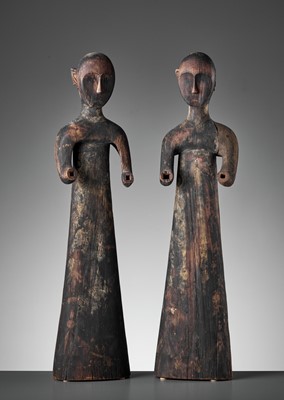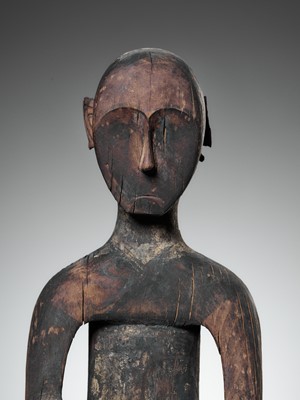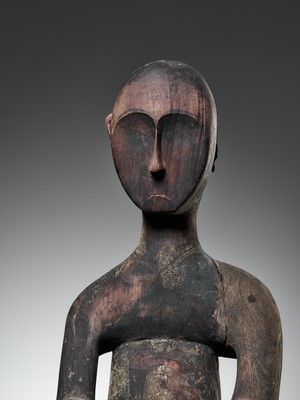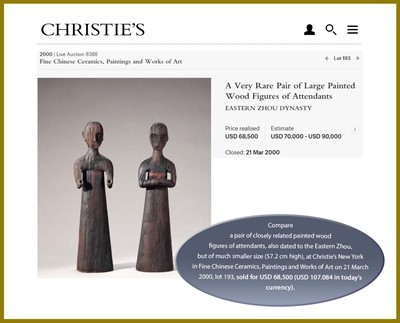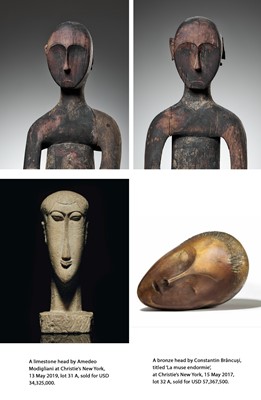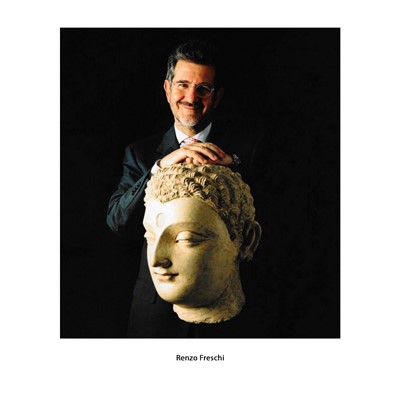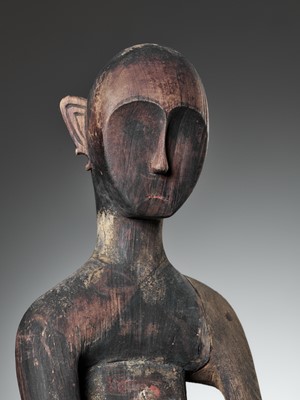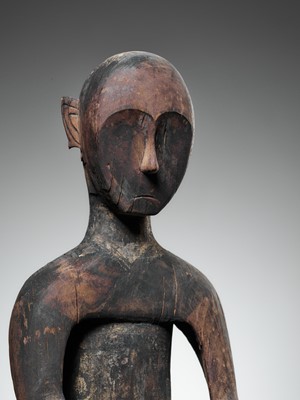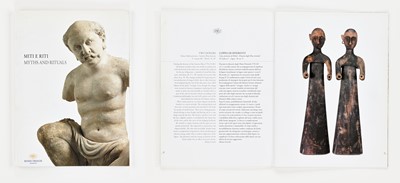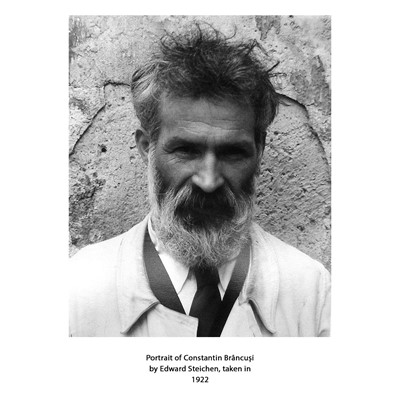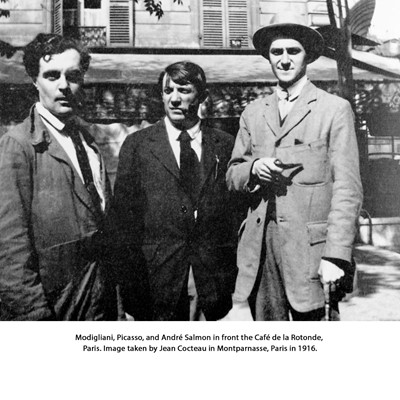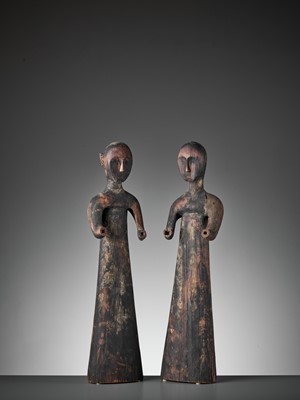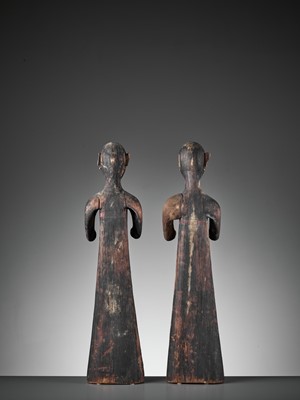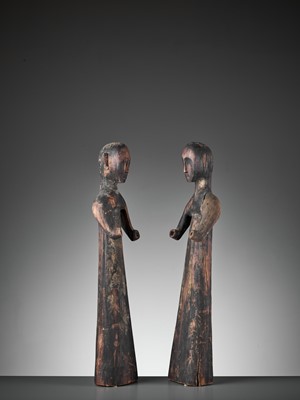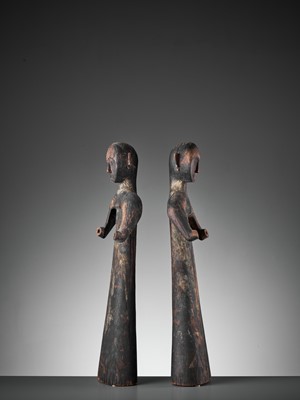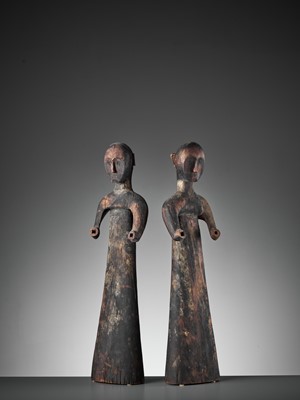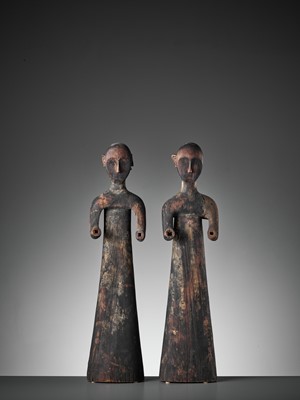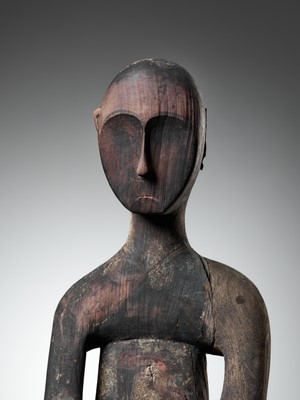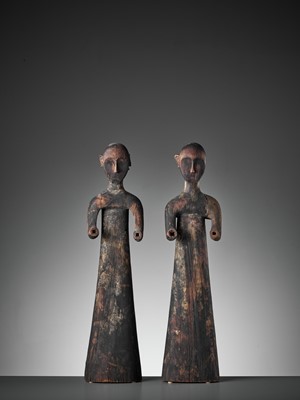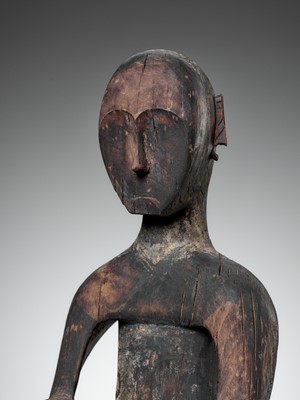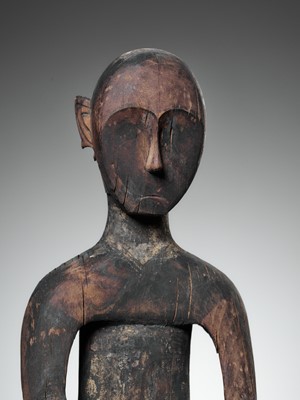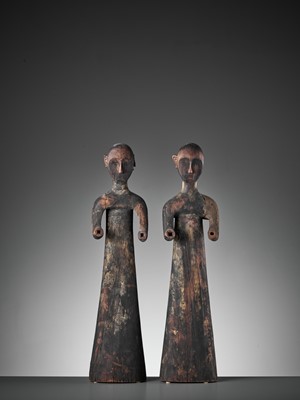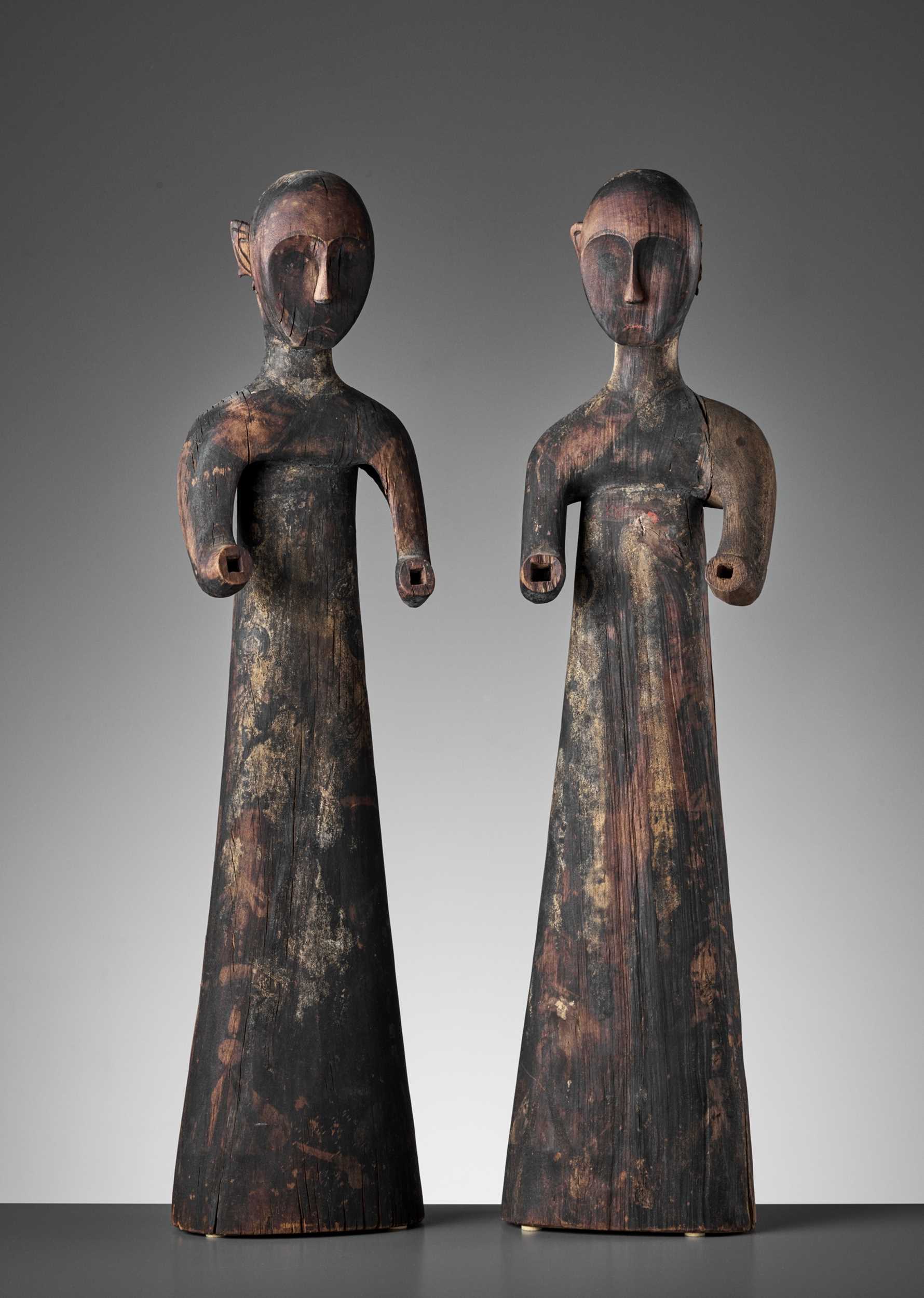16th Oct, 2021 10:00
TWO-DAY AUCTION - Fine Chinese Art / 中國藝術集珍 / Buddhism & Hinduism
360
A PAIR OF PAINTED WOODEN ‘BEAUTIES’, EASTERN ZHOU DYNASTY
東周一對彩繪美人木像
Sold for €32,864
including Buyer's Premium
China, 4th century BC. Elegantly yet plainly carved. Each female figure with a large oval head, strikingly scooped out and painted with almond-shaped eyes below the arched eyebrows, centered by a slender nose with triangular tip, the ears pierced for rings, the frowning mouth simply incised. The shoulders are rounded while the slender arms show square mortise holes carved for separate hands. The long robes falling in gently spreading cones.
Provenance: Renzo Freschi, Milan, 2008. A private collection in New England, USA, acquired from the above.
Condition: Excellent condition, commensurate with age. Some weathering, old wear and losses. Natural age cracks, some with minor old fills. Chips and nicks as well as signs of erosion. Remnants of ancient polychrome pigment. One of the figures with the proper left arm replaced.
Published: Renzo Freschi Oriental Art, Miti e Riti (Myths and Rituals), Milan, 2008.
Weight: 3,196 and 3,326 g
Dimensions: Height 70.5 and 71 cm
Given the perishable nature of wood, such figures are extremely rare, the later pottery statues and vessels being much more common. The practice of burying wood figures began in the Eastern Zhou dynasty and flourished during the Kingdom of Chu (740-330 BC). Several wood statues have been excavated from Chu tombs in Changsha, Hunan.
Expert’s note: The present wood sculptures, despite being around 2,400 years old, bear a striking resemblance to the works of Amedeo Modigliani (1884-1920) and Constantin Brâncuși (1876-1957), two pioneers of Modernism who worked mainly in France. Given the huge interest in Chinese art among Western European artists during the late 19th and early 20th centuries, it is easily conceivable that both artists were influenced by figures from this group. English sculptor Jacob Epstein once recalled that Modigliani had filled his studio with “nine or ten long heads and one figure. He would place candles on the top of each one and the effect was that of a primitive temple. It was said that Modigliani, when under the influence of hashish, embraced these sculptures.” Modigliani seems to have conceived his works as if they were sacred. For him, his sculptures were all component parts of a vast, greater enterprise. Through his work, Modigliani had, by all accounts, come to dream of creating what he called a “Temple of Beauty”. At the basis of Modigliani’s sculptural vision was an innate concept of a sublime, timeless and all-encompassing beauty. Today, debate continues to rage amongst art historians and other admirers of Modigliani’s stone heads about the range and degree of impact brought to bear by such wide-ranging influences as African, Greek, Roman, Egyptian, Near-Eastern and Oriental art, upon his extraordinarily rich, elegant and multifaceted sculptures. Looking at the present pair of Zhou dynasty beauties, it becomes quite clear that Chinese sculpture must have played a certain role in the creation of Modigliani’s iconic heads.
Literature comparison: For a closely related painted wood figure, dated to the Eastern Zhou, circa 3rd Century BC, see J.J. Lally & Co. Oriental Art, Two Thousand Years of Chinese Sculpture, New York, 2008, no. 2. Another closely related figure was included in the exhibition, Early Chinese art: 8th century BC - 9th century AD, Eskenazi, London, 6 June - 8 July 1995, no. 45.
Auction result comparison: Compare a pair of closely related painted wood figures of attendants, also dated to the Eastern Zhou, but of much smaller size (57.2 cm high), at Christie’s New York in Fine Chinese Ceramics, Paintings and Works of Art on 21 March 2000, lot 193, sold for USD 68,500 (USD 107,084 in today’s currency).
東周一對彩繪美人木像
中國,公元前四世紀。雕琢優雅而樸素,每一個美女木像都有一個巨大的橢圓形頭,在拱形眉毛下畫著杏仁形的眼,以一個三角形尖端的細長鼻子為中心,耳朵穿孔用來佩戴耳環,小嘴簡單地刻畫。削肩,而細長的手臂帶著為分開裝置的雙手雕刻的方形榫眼。 長裙下垂輕微展開。
來源:米蘭Renzo Freschi 2008;美國新英格蘭區私人收藏,購於上述收藏。
品相:品相極好,與年齡相稱。 一些風化、舊磨損和缺損,自然年齡裂縫,有些帶有輕微的舊填充。 切屑和刻痕以及侵蝕跡象。 彩繪殘餘。一個人像左手臂經過替換。
出版: Renzo Freschi Oriental Art, Miti e Riti (Myths and Rituals), 米蘭, 2008。
重量:3,196 及 3,326 克
尺寸:高70.5 與 71 厘米
專家注釋:儘管現在的木像已有約 2400 年的歷史,但與 Amedeo Modigliani(1884-1920)和 Constantin Brâncuși(1876-1957)這兩位法國現代主義先驅的作品有著驚人的相似之處。鑑於 19 世紀末和 20 世紀初西歐藝術家對中國藝術的濃厚興趣,不難想像這兩位藝術家都受到了這類造像的影響。英國雕塑家Jacob Epstein曾回憶說,Modigliani的工作室裡擺滿了“九個或十個長頭和一個人物”。他“會在每根蠟燭的頂部放置蠟燭,效果就像一座原始寺廟。據說Modigliani在大麻的影響下接受了這些雕塑。” Modigliani似乎認為他的作品是神聖的。對他來說,他的雕塑都是一個龐大而偉大事業的組成部分。眾所周知,Modigliani通過他的工作,夢想著創造一座他所謂的“美麗之殿”。Modigliani雕塑視覺的基礎是一種崇高、永恆和包羅萬象的美的與生俱來的概念。今天,藝術史學家和Modigliani石像的崇拜者繼續激烈爭論討論非洲、希臘、羅馬、埃及、近東和東方藝術等對他的影響的範圍和程度。看看現在這對周朝美女,很明顯,中國雕塑在Modigliani標誌性頭像的創作中起到了一定的作用。
拍賣結果比較:一對東周彩繪侍者木像,尺寸更小 (高57.2 厘米),見紐約佳士得 Fine Chinese Ceramics, Paintings and Works of Art 2000年3月21日,lot 193, 售價USD 68,500 (USD 107.084 當前的匯率)。
China, 4th century BC. Elegantly yet plainly carved. Each female figure with a large oval head, strikingly scooped out and painted with almond-shaped eyes below the arched eyebrows, centered by a slender nose with triangular tip, the ears pierced for rings, the frowning mouth simply incised. The shoulders are rounded while the slender arms show square mortise holes carved for separate hands. The long robes falling in gently spreading cones.
Provenance: Renzo Freschi, Milan, 2008. A private collection in New England, USA, acquired from the above.
Condition: Excellent condition, commensurate with age. Some weathering, old wear and losses. Natural age cracks, some with minor old fills. Chips and nicks as well as signs of erosion. Remnants of ancient polychrome pigment. One of the figures with the proper left arm replaced.
Published: Renzo Freschi Oriental Art, Miti e Riti (Myths and Rituals), Milan, 2008.
Weight: 3,196 and 3,326 g
Dimensions: Height 70.5 and 71 cm
Given the perishable nature of wood, such figures are extremely rare, the later pottery statues and vessels being much more common. The practice of burying wood figures began in the Eastern Zhou dynasty and flourished during the Kingdom of Chu (740-330 BC). Several wood statues have been excavated from Chu tombs in Changsha, Hunan.
Expert’s note: The present wood sculptures, despite being around 2,400 years old, bear a striking resemblance to the works of Amedeo Modigliani (1884-1920) and Constantin Brâncuși (1876-1957), two pioneers of Modernism who worked mainly in France. Given the huge interest in Chinese art among Western European artists during the late 19th and early 20th centuries, it is easily conceivable that both artists were influenced by figures from this group. English sculptor Jacob Epstein once recalled that Modigliani had filled his studio with “nine or ten long heads and one figure. He would place candles on the top of each one and the effect was that of a primitive temple. It was said that Modigliani, when under the influence of hashish, embraced these sculptures.” Modigliani seems to have conceived his works as if they were sacred. For him, his sculptures were all component parts of a vast, greater enterprise. Through his work, Modigliani had, by all accounts, come to dream of creating what he called a “Temple of Beauty”. At the basis of Modigliani’s sculptural vision was an innate concept of a sublime, timeless and all-encompassing beauty. Today, debate continues to rage amongst art historians and other admirers of Modigliani’s stone heads about the range and degree of impact brought to bear by such wide-ranging influences as African, Greek, Roman, Egyptian, Near-Eastern and Oriental art, upon his extraordinarily rich, elegant and multifaceted sculptures. Looking at the present pair of Zhou dynasty beauties, it becomes quite clear that Chinese sculpture must have played a certain role in the creation of Modigliani’s iconic heads.
Literature comparison: For a closely related painted wood figure, dated to the Eastern Zhou, circa 3rd Century BC, see J.J. Lally & Co. Oriental Art, Two Thousand Years of Chinese Sculpture, New York, 2008, no. 2. Another closely related figure was included in the exhibition, Early Chinese art: 8th century BC - 9th century AD, Eskenazi, London, 6 June - 8 July 1995, no. 45.
Auction result comparison: Compare a pair of closely related painted wood figures of attendants, also dated to the Eastern Zhou, but of much smaller size (57.2 cm high), at Christie’s New York in Fine Chinese Ceramics, Paintings and Works of Art on 21 March 2000, lot 193, sold for USD 68,500 (USD 107,084 in today’s currency).
東周一對彩繪美人木像
中國,公元前四世紀。雕琢優雅而樸素,每一個美女木像都有一個巨大的橢圓形頭,在拱形眉毛下畫著杏仁形的眼,以一個三角形尖端的細長鼻子為中心,耳朵穿孔用來佩戴耳環,小嘴簡單地刻畫。削肩,而細長的手臂帶著為分開裝置的雙手雕刻的方形榫眼。 長裙下垂輕微展開。
來源:米蘭Renzo Freschi 2008;美國新英格蘭區私人收藏,購於上述收藏。
品相:品相極好,與年齡相稱。 一些風化、舊磨損和缺損,自然年齡裂縫,有些帶有輕微的舊填充。 切屑和刻痕以及侵蝕跡象。 彩繪殘餘。一個人像左手臂經過替換。
出版: Renzo Freschi Oriental Art, Miti e Riti (Myths and Rituals), 米蘭, 2008。
重量:3,196 及 3,326 克
尺寸:高70.5 與 71 厘米
專家注釋:儘管現在的木像已有約 2400 年的歷史,但與 Amedeo Modigliani(1884-1920)和 Constantin Brâncuși(1876-1957)這兩位法國現代主義先驅的作品有著驚人的相似之處。鑑於 19 世紀末和 20 世紀初西歐藝術家對中國藝術的濃厚興趣,不難想像這兩位藝術家都受到了這類造像的影響。英國雕塑家Jacob Epstein曾回憶說,Modigliani的工作室裡擺滿了“九個或十個長頭和一個人物”。他“會在每根蠟燭的頂部放置蠟燭,效果就像一座原始寺廟。據說Modigliani在大麻的影響下接受了這些雕塑。” Modigliani似乎認為他的作品是神聖的。對他來說,他的雕塑都是一個龐大而偉大事業的組成部分。眾所周知,Modigliani通過他的工作,夢想著創造一座他所謂的“美麗之殿”。Modigliani雕塑視覺的基礎是一種崇高、永恆和包羅萬象的美的與生俱來的概念。今天,藝術史學家和Modigliani石像的崇拜者繼續激烈爭論討論非洲、希臘、羅馬、埃及、近東和東方藝術等對他的影響的範圍和程度。看看現在這對周朝美女,很明顯,中國雕塑在Modigliani標誌性頭像的創作中起到了一定的作用。
拍賣結果比較:一對東周彩繪侍者木像,尺寸更小 (高57.2 厘米),見紐約佳士得 Fine Chinese Ceramics, Paintings and Works of Art 2000年3月21日,lot 193, 售價USD 68,500 (USD 107.084 當前的匯率)。
Zacke Live Online Bidding
Our online bidding platform makes it easier than ever to bid in our auctions! When you bid through our website, you can take advantage of our premium buyer's terms without incurring any additional online bidding surcharges.
To bid live online, you'll need to create an online account. Once your account is created and your identity is verified, you can register to bid in an auction up to 12 hours before the auction begins.
Intended Spend and Bid Limits
When you register to bid in an online auction, you will need to share your intended maximum spending budget for the auction. We will then review your intended spend and set a bid limit for you. Once you have pre-registered for a live online auction, you can see your intended spend and bid limit by going to 'Account Settings' and clicking on 'Live Bidding Registrations'.
Your bid limit will be the maximum amount you can bid during the auction. Your bid limit is for the hammer price and is not affected by the buyer’s premium and VAT. For example, if you have a bid limit of €1,000 and place two winning bids for €300 and €200, then you will only be able to bid €500 for the rest of the auction. If you try to place a bid that is higher than €500, you will not be able to do so.
Online Absentee and Telephone Bids
You can now leave absentee and telephone bids on our website!
Absentee Bidding
Once you've created an account and your identity is verified, you can leave your absentee bid directly on the lot page. We will contact you when your bids have been confirmed.
Telephone Bidding
Once you've created an account and your identity is verified, you can leave telephone bids online. We will contact you when your bids have been confirmed.
Classic Absentee and Telephone Bidding Form
You can still submit absentee and telephone bids by email or fax if you prefer. Simply fill out the Absentee Bidding/Telephone bidding form and return it to us by email at office@zacke.at or by fax at +43 (1) 532 04 52 20. You can download the PDF from our Upcoming Auctions page.
How-To Guides
How to Create Your Personal Zacke Account
How to Register to Bid on Zacke Live
How to Leave Absentee Bids Online
How to Leave Telephone Bids Online
中文版本的操作指南
创建新账号
注册Zacke Live在线直播竞拍(免平台费)
缺席投标和电话投标
Third-Party Bidding
We partner with best-in-class third-party partners to make it easy for you to bid online in the channel of your choice. Please note that if you bid with one of our third-party online partners, then there will be a live bidding surcharge on top of your final purchase price. You can find all of our fees here. Here's a full list of our third-party partners:
- 51 Bid Live
- EpaiLive
- ArtFoxLive
- Invaluable
- LiveAuctioneers
- the-saleroom
- lot-tissimo
- Drouot
Please note that we place different auctions on different platforms. For example, in general, we only place Chinese art auctions on 51 Bid Live.
Bidding in Person
You must register to bid in person and will be assigned a paddle at the auction. Please contact us at office@zacke.at or +43 (1) 532 04 52 for the latest local health and safety guidelines.
